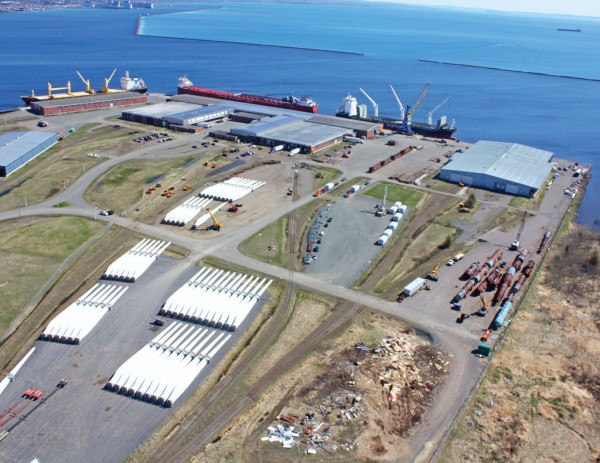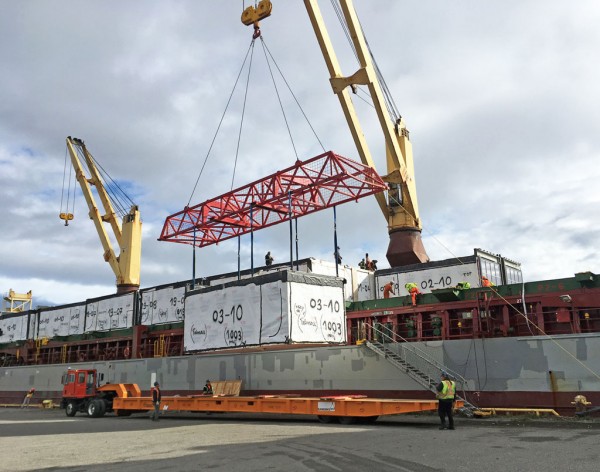General cargo hits 31,000 tons with Thunder Bay’s diversified cargo strategy.
Located at the head of the Great Lakes/St. Lawrence Seaway System, the Port of Thunder Bay was long chiefly known as the eastern gateway of choice for grain exports from Canada’s Prairie provinces. Grain throughput has declined from peaks of more than 17 million metric tons in the early 1980s to just 7.2 million tons in 2017 due mainly to changing Canadian export grain trade patterns shifting from Europe to the Far East. But a diversification strategy, bolstered by the Keefer general cargo terminal equipped with a mobile harbor crane since 2012, has steadily transformed the port into a competitive player on North America’s virtual inland seas in breakbulk, project and dimensional cargo.

The numbers show the port’s general cargo tripling to 31,000 tons last year compared with 2010. Among the key items are wind turbine blades, nacelles and towers, mining equipment, Alberta oilsands components, and steel coils. Wind energy, indeed, is a fast-growing business source for the port in light of its direct rail access (CN and Canadian Pacific Railway) to Saskatchewan, Alberta and British Columbia where various wind farm projects are underway.
Project Business
“We had the most stevedore hours in 10 years at the general cargo terminal in 2017,” indicated Tim Heney, President and CEO of the TBPA. These included 16 project-related shipments through the terminal – just one shy of a record 17 in 2015.
“To attract business, we have enhanced the laydown area,” noted Heney. “We have capitalized on the infrastructure of the general cargo terminal to provide value to the shipper. Diversifying our cargo base has been a main initiative since 2004.”

The 80 acre Keefer facility encompasses a 10-acre intermodal yard and over 500,000 square feet of warehouse space. Logistec Stevedoring is the primary cargo handler.
Inbound steel products are on the rise. Steel piping from Germany destined for the Alberta oil industry was a highlight of 2017. “We have been after this type of cargo for some time, and we see strong potential for repeat cargo,” Heney said.
Additional infrastructure improvement is on the drawing board – notably a terminal reconfiguration project that could cost C$15 million. This would comprise rail upgrades and a heated storage building. Federal government financial support has been requested.
Targeting European Trade with Western Canada
Meanwhile, significantly enough, in late 2017, the Port of Thunder Bay refreshed its corporate brand with a new logo and tagline – The Superior Way West. This supports a strategic growth objective and vision as the preferred marine route for European trade with western Canada.
In an interview, Heney told AJOT: “One of the things that have helped us has been the liner concept introduced several years ago by (Dutch multi-purpose carrier) Spliethoff. Prior to that, it used to be full shiploads. Now we are getting a lot more smaller shipments, part shipments.”
At the same time, Montreal-based Fednav has long been providing shippers with a liner service from Europe through the St. Lawrence Seaway and Great Lakes for a wide range of breakbulk cargo.
Regarding competition with such regional U.S. ports as Duluth, Heney suggested that Thunder Bay benefited from several advantages. “There is no Harbor Maintenance Tax as applicable to U.S. ports. The (weaker) Canadian dollar is, of course, in our favor. You have one customs clearance coming to Canada through Thunder Bay rather than Duluth. We also have the best rail clearances in western Canada.”
Continuing, Heney stated: “We determine ways to be competitive with other supply chains and to attract cargo that not only would have taken other routes but other ports, including coastal ports. There are different ways to ship products for projects to Alberta, Manitoba and Saskatchewan.”
Modular Hotel Units from Poland
By way of a striking recent example, Heney evoked the handling of modular hotel units for delivery to Calgary in a logistics operation covering thousands of miles and transportation shipments on land and sea.
To start with, some 156 modules manufactured by Poland’s Polcom Group in Topola were transported 125 kms south to the port of Gdansk. At the large Baltic Sea port, the modules were transferred from Poland via ship for Thunder Bay where they were offloaded last September by Logistec Stevedoring.

Working with the Thunder Bay Port Authority (TBPA) “has been an absolute pleasure,” remarked Laurie Ritter, Modular Cargo/International Trade Specialist at Polcom USA LLC. “The logistics portion of these projects requires a relationship to be established well in advance of arrival and pricing can affect where our vessel arrives.”
According to Ritter, “Thunder Bay provides a cost-effective water-arrival option to Central and Western Canada without compromising security, inland resources and specialty needs.”
In 2017, the hotel modules were a first for the Port of Thunder Bay. Another first was the previously-mentioned steel piping for Alberta by train. Other moves involved heavy machinery, electrical transformers, wind turbines from Germany for northern British Columbia, wood pellets from Norway and structural steel from Spain and Luxembourg for western Canada. This all added up to a banner year for project cargo.

Follow us on social media: